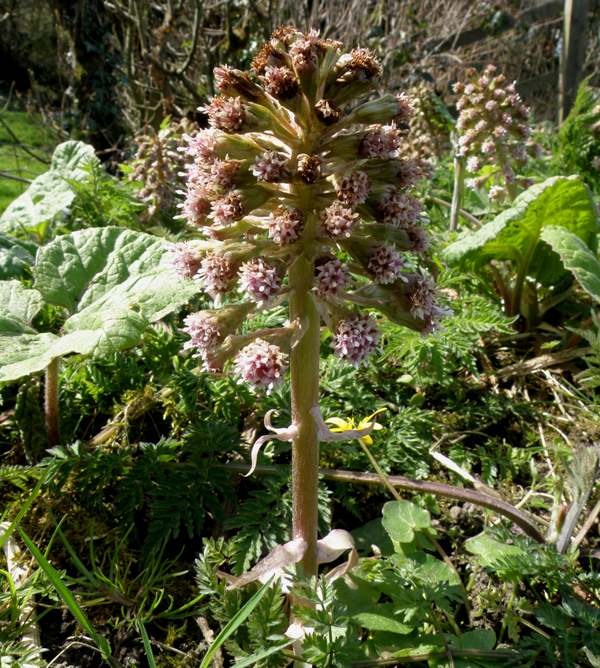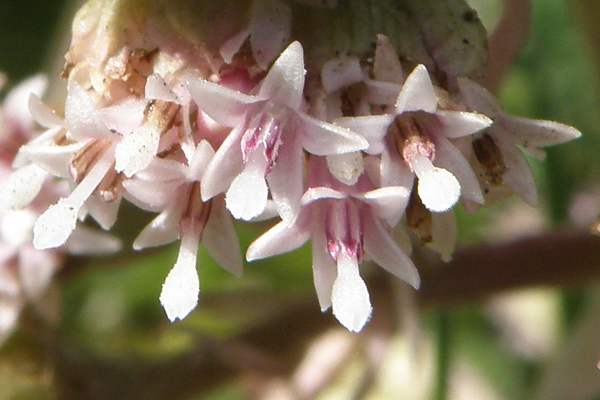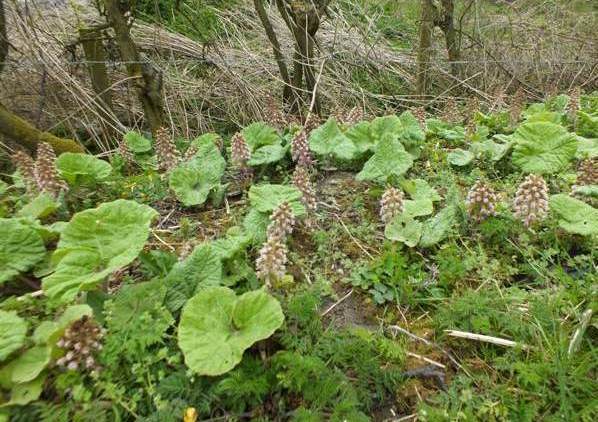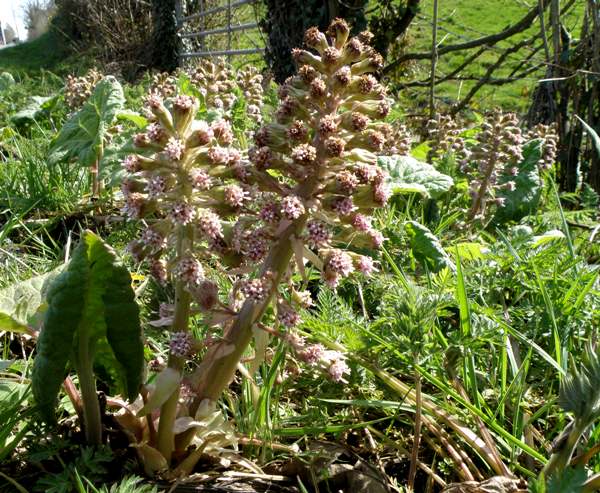Petasites hybridus - Butterbur
Phylum: Magnoliophyta - Class: Equisetopsida - Order: Asterales - Family: Asteraceae

This distinctive spring wildflower often forms dense patches of colour in shaded boggy places and on disturbed roadside verges. The flowers appear before the leaves, and as summer approaches the flowers decay while the leaves continue to grow bigger, eventually looking rather like rhubarb - as a result this member of the asteraceae family of flowers is also sometimes referred to as Bog Rhubarb.

Description
Fowering spikes emerge from the ground in March before the leaves appear, and the flowers persist through April and often well in to May. The toothed, heart-shaped leaves usually emerge in early May and continue growing until late summer, by which time they can be up to a metre across. Although matt or felt-like and mid green on their upper surfaces, the leaves have light-grey and distinctly hairy undersides.
Male and female flowers occur on separate plants (so this is a dioecious species, literally meaning 'having two houses'); however, in Britain it seems that female plants are quite a rarity. We are grateful to Patrick Gibb, who informed us that the explanation usually given for this unequal distribution is that beekeepers planted the males around the country as a valuable source of early nectar and pollen. Female inflorescences can be up to 70cm tall, while male plants are reported to be much shorter and more squat on average and with more densely-packed flowerheads. Each floret comprises typically 15 to 25 individual five-petalled pink flowers.
Habitat
Most often seen in damp, shaded places such as wet meadows, damp woodlands, stream banks and ditches, Butterbur is particularly conspicuous when it colonises disturbed roadside verges and marshy waste land.

Distribution
Petasites hybridus is native to much of northern and central Europe including Britain and Ireland, where it is quite a common sight. It's range (possibly due to introduction) extends as far north as Finland and southwards into Spain. To the east the range of this species extends into much of Asia
Blooming times
In Britain and Ireland Butterbur produces its flowers from March to May.
Uses
The common name Butterbur comes from a past use of the leaves - as a protective wrapping for butter. Bees is particular benefit from this nectar-rich wildflower because it blooms early in the year when few other wildflowers are in flower.
Similar species
An introduced species, Petasites albidus, is very similar but has white flowers. Another, earlier-blooming wildflower with which Butterbur is sometimes confused is Winter Heliotrope, Petasites fragrans; as its scientific name suggests, this is a scented flower, whereas Butterbur has no discernible scent. The other obvious difference is that there are far fewer flowers on the lax spikes of Winter Heliotrope, whose leaves are much smaller than those of Butterbur.

Etymology
The genus name Petasites comes from the Greek noun 'petasos', meaning a broad-brimmed hat, a term also applied to the winged hat worm by Hermes, the messenger of the gods in Greek mythology (Mercury in Roman mythology); it is a reference to the broad leaves of plants in this genus. Confusingly, despite its specific epitet that suggests it is a cross between two different Petasites species, Butterbur Petasites hybritus is accepted by botanical authorities as a distinct species.
The Butterbur specimens shown on this page were photographed in Wales during April and May.
Please Help Us: If you have found this information interesting and useful, please consider helping to keep First Nature online by making a small donation towards the web hosting and internet costs.
Any donations over and above the essential running costs will help support the conservation work of Plantlife, the Rivers Trust and charitable botanic gardens - as do author royalties and publisher proceeds from books by Pat and Sue.

